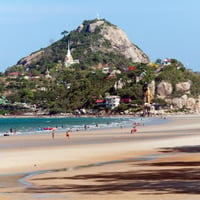Public Transportation in Bangkok
Summary: Mastering the public transportation system in Bangkok is a crucial aspect of adapting to life there. This article provides a detailed overview of the available local transit options.
Bangkok, the bustling capital of Thailand, is a vibrant city known for its rich culture, delicious street food, and iconic temples. For digital nomads who have chosen this city as their temporary base, navigating the maze of streets and alleys can be a daunting task. Fortunately, Bangkok offers a variety of public transportation options that are both affordable and efficient, making it easy to explore the city or commute to a co-working space. Here's a guide to the public transportation available in Bangkok, along with some tips to ensure a safe and pleasant journey.
BTS Skytrain
The BTS Skytrain is one of the most popular modes of transportation for both locals and expats. It operates two main lines: the Sukhumvit Line and the Silom Line, which cover most of the central city and the business districts. The Skytrain is known for its cleanliness, speed, and punctuality, making it an excellent choice for avoiding the notorious Bangkok traffic. Fares are based on distance traveled, and rechargeable Rabbit cards can be used for convenience. More information can be found on the official BTS website at www.bts.co.th.
MRT Metro
The MRT Metro is another efficient way to get around Bangkok. It serves two lines: the Blue Line and the Purple Line, which connect many parts of the city not covered by the BTS. The MRT is interconnected with the BTS at several stations, making transfers between the two systems seamless. Like the BTS, the MRT is known for its timeliness and modern facilities. Fares are also distance-based, and the MRT uses a token system or a rechargeable card for payment. Visit the official MRT website at www.bangkokmetro.co.th for more details.
Buses
Bangkok's bus network is extensive and can take you almost anywhere in the city. Buses are the cheapest mode of public transportation, but they can be slower due to traffic and a bit more challenging to navigate for non-Thai speakers. There are both air-conditioned and non-air-conditioned buses available. The Bangkok Mass Transit Authority (BMTA) provides maps and route information on their website at www.bmta.co.th.
Boats
The Chao Phraya River and the canals of Bangkok offer an alternative and scenic route through the city. The Chao Phraya Express Boat operates along the river and is a great way to avoid traffic while enjoying views of the waterfront. There are also canal boats (or khlong boats) that ply the Saen Saep Canal, providing a quick way to travel east-west across the city. Fares are inexpensive, and the boats run at regular intervals throughout the day.
Taxis and Tuk-Tuks
Taxis are widely available throughout Bangkok and are metered, with fares starting at a reasonable rate. However, it's important to ensure the driver turns on the meter to avoid being overcharged. Tuk-tuks, the iconic three-wheeled vehicles, are also a common sight in Bangkok. While they can be a fun experience, they are usually more expensive than taxis and do not have meters, so it's advisable to negotiate the fare before starting your journey.
Bikes
For short distances or exploring local neighborhoods, renting a bike can be a pleasant option. Bangkok has a public bike-sharing program called Pun Pun Bike Share, where you can pick up and drop off bicycles at various stations around the city. Cycling in Bangkok can be challenging due to the traffic and heat, so it's best suited for experienced urban cyclists.
Helpful Apps
Several apps can make navigating Bangkok's public transportation network easier. Applications like Google Maps, Moovit, and Transit Bangkok provide real-time information on routes, schedules, and connections. For taxis, ride-hailing apps like Grab offer convenient booking and fare estimates, ensuring a hassle-free travel experience.
Safety
When using public transportation in Bangkok, safety should always be a priority. Keep an eye on your belongings, especially in crowded areas. During peak hours, the BTS and MRT can get very crowded, so be mindful of pickpockets. It's also important to follow traffic rules and be cautious when crossing streets, as traffic can be unpredictable. At night, it's advisable to use more secure transportation options like taxis or ride-hailing services, especially when traveling alone.
With a variety of transportation options at your fingertips, getting around Bangkok as a digital nomad can be both an adventure and an opportunity to immerse yourself in the local way of life. By planning your routes, staying aware of your surroundings, and embracing the city's rhythm, you can make the most of your time in this dynamic metropolis.
About the Author
 Joshua Wood, LPC is one of the Founders of Digital Nomad Exchange and serves as Co-President of Expat Exchange. Prior to Expat Exchange and Digital Nomad Exchange, Joshua worked for NBC Cable (MSNBC and CNBC
Primetime). Joshua has a BA from Syracuse and a Master's in Clinical and Counseling Psychology from Fairleigh Dickinson University. Mr. Wood is also a licensed counselor and psychotherapist.
Joshua Wood, LPC is one of the Founders of Digital Nomad Exchange and serves as Co-President of Expat Exchange. Prior to Expat Exchange and Digital Nomad Exchange, Joshua worked for NBC Cable (MSNBC and CNBC
Primetime). Joshua has a BA from Syracuse and a Master's in Clinical and Counseling Psychology from Fairleigh Dickinson University. Mr. Wood is also a licensed counselor and psychotherapist.
Some of Joshua's articles include Pros and Cons of Living in Portugal, 10 Best Places to Live in Ireland and Pros and Cons of Living in Uruguay. Connect with Joshua on LinkedIn.

SJB Global is a top-rated financial advisory firm specializing in expat financial advice worldwide, offering retirement planning & tax-efficient solutions with a regressive fee model.
Learn More
 SJB Global
SJB GlobalSJB Global is a top-rated financial advisory firm specializing in expat financial advice worldwide, offering retirement planning & tax-efficient solutions with a regressive fee model.
Learn More
![]() Thailand Forum
Thailand Forum
Talk with other digital nomads and expats in Thailand on our Thailand forum - meet people, get advice and help others.
![]() Contribute
Contribute
Help others in Thailand by answering questions about the challenges and adventures of living in Thailand.
Digital Nomads in Thailand offer advice about healthcare, hospital visits, emergency rooms visits, finding a doctor and buying health insurance in Thailand.




